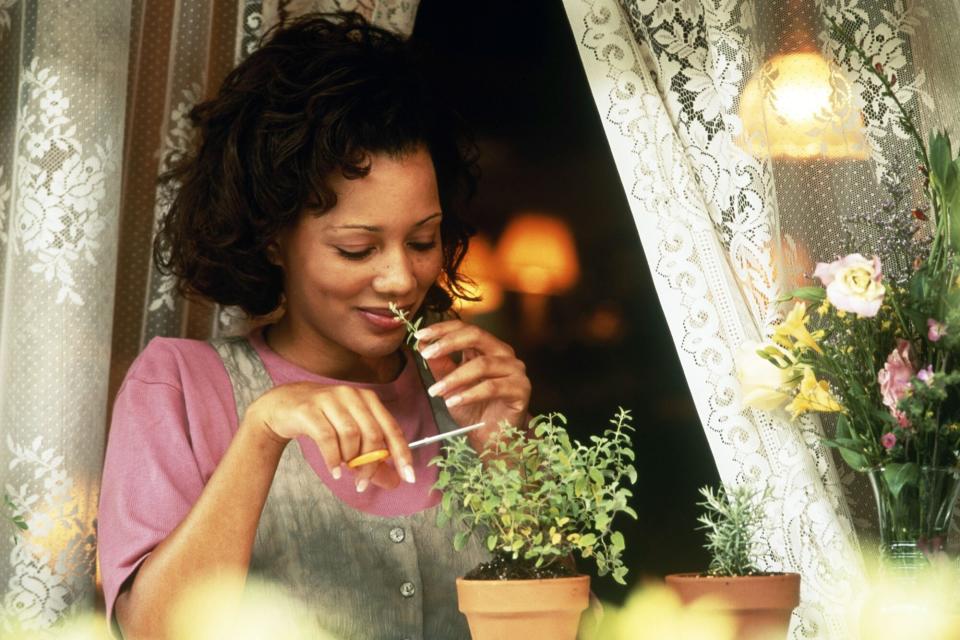A Comprehensive Guide to Oregano: How to Grow, Prune, Dry, and Store the Herb
Oregano has the potential to take any dish to the next level and it's one of our favorite aromatics to place atop a slice of pizza or work into a delicious marinade for any number of meals. Learning how to grow oregano yourself not only eliminates trips to the grocery store, but it'll also help save you money in the long run. If you're considering growing the herb yourself, we're sharing a one-stop guide on how to grow, prune, dry, and store oregano.
Related: A Guide to Growing Kitchen Windowsill Herbs

Terry Vine / Getty Images
Where to Grow Oregano
Oregano is easy to maintain and can be grown inside or out. Nandita Godbole, botanist, landscape architect, and author of Seven Pots of Tea: an Ayurvedic Approach to Sips and Nosh ($35, amazon.com), says, "Oregano is one of the easiest herbs to grow. This is a perennial in plant zones six or lower, and an evergreen in plant zones seven and up. In the right conditions, this herb can live more than four years."
Be sure to plant your herb in an area with lots of sun for its best chance to flourish, according to Dominique Charles, gardener and garden consultant with Plots and Pans. "Make sure your plant is well placed to receive optimal growth," she says. Plant your seeds or clippings once you are solidly in spring, avoiding any potential for frost which will ruin your hard work. It's also a good idea to cover your soil with mulch for protection if you are in a colder climate. If you live in a naturally warm climate, set your oregano plants up in an area with some shade.
How to Grow Oregano
If you plan to grow oregano from seeds, you can simply mist the seeds, cover them in plastic wrap, set them in the sun, and wait about a week for the seeds to germinate. Ryan McEnaney, public relations and communications specialist for Bailey Nurseries, says that since seeds are incredibly small, it's a good idea to scatter them on top of the soil, allowing them to germinate over the next month before being transplanted outdoors following the final frost.
Take your sprouted plants or clippings and space them 8-to- 10-inches apart, and ensure that they have well-drained but moist soil. To test, stick your index finger about an inch down into the soil. If it feels dry, it's time to water. "Because it is a low growing herb, many gardeners plant oregano in the front part of a garden border, so they can harvest the herb easily and are able to watch for any bugs," says Godbole.
If you're testing the pH of the soil (which you should), look for it to be somewhere between 6.5 and 7.0. It is also worth finding a good quality plant food with compost to promote steady and plentiful growth. "To avoid issues, be sure not to overwater your plant and allow enough airflow between plants to avoid possible foliar diseases. Most pests don't bother oregano, but aphids and spider mites may sometimes be found on oregano. Pick off any browning leaves and spray any infested leaves with a strong stream of water. If an infestation continues, neem oil can be applied," says McEnaney.
How to Prune Oregano
Once your oregano plants reach around four-inches in height, according to the Old Farmer's Almanac, they're ready to be pruned. McEnaney says to use extra sharp kitchen scissors—warning against garden shears—to clip the leaves you want. For continued healthy growth, prune your plants regularly, the Almanac states. Be mindful of the number of sprigs you snip—you never want to cut more than three inches away from the base. If you're pruning a larger quantity, cut just above the plant's lowest set of leaves. This will encourage the next season's growth. When it comes to pruning your herbs before drying, Godbole says, "Choose stems that do not have flowers yet. If you cut too close to the base of the plant, the plant may not be able to recover or grow back."
How to Dry Oregano
Oregano flavor is most pungent in the middle of the summer, so this is the perfect time to prune and dry the herb. You can dry your herbs by hanging them up with twine in a shaded area of your home, letting them rest for about a week before taking them down. "As you harvest clumps of oregano, tie it loosely together and hang the clump on a drying rack for roughly two weeks until completely dry before removing the leaves and crumbling into a jar for preservation," says McCenaney.
Charles suggests another quick option: popping them in the oven for about 40 minutes. Set your oven to about 200 degrees, and place them on a cookie sheet on the center rack of the oven. After removing them, let them cool for about 30 minutes before storing or adding them to your dinner.
How to Store Oregano
Store the dried oregano in an airtight container until you're ready to use it. Oregano can also be stored in the fridge (with stems in a glass of water) or frozen for later use. Don't bother chopping before putting them away—you can store the sprigs whole. As a final tip for success, Godbole says, "A few fresh leaves of oregano will do the same trick as a pinch of dried oregano. For those who use it throughout the year, harvesting the leaves before the plant flowers, and then drying it properly, will create many batches of home-grown, flavorful, dried oregano."

